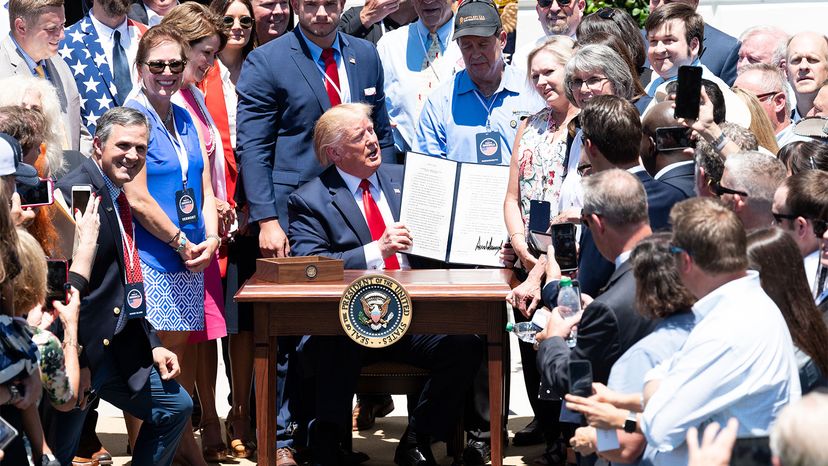Controversial Executive Orders

Executive orders offer a powerful and immediate way for a president to advance his policy priorities. A White House aide to President Bill Clinton described the lure of executive orders this way: "Stroke of the pen, law of the land" [source: Bennett].
President Ronald Reagan used the direct power of executive orders to peel back layers of government regulation that he and his administration believed were hampering economic growth. President George W. Bush signed executive orders that approved more aggressive surveillance after 9/11 and limited public access to presidential documents. President Barack Obama increasingly relied on executive orders to forward his agenda in the face of an intransigent Congress. And President Donald Trump signed dozens of executive orders to push his divisive immigration policies and remove "burdensome" regulations.
Advertisement
President George W. Bush issued several controversial executive orders surrounding the gathering of intelligence in the war on terror. Arguably the most controversial was a secret executive order he signed in 2002, authorizing the National Security Agency (NSA) to eavesdrop without a warrant on phone calls made by U.S. citizens and others living in the United States.
On his very first day in office, President Obama signed three executive orders to draw a clear distinction between the policies of his administration and his predecessor's. One of the orders essentially banned the use of "enhanced" interrogation techniques like waterboarding and instructed the CIA and the armed forces to strictly follow the interrogation procedures outlined in the Army field manual [source: CNN]. The most controversial executive order called for the closure of the Guantanamo Bay detention facility within a year, which ultimately failed to happen.
President Trump signed 55 executive orders in his first year in office — more than any president since Lyndon Johnson — including directives for building his promised 2,000-mile (3,218-kilometer) wall along the border with Mexico and attempts to dismantle the Affordable Care Act. Ironically, Trump had previously criticized Obama for signing executive orders, seeing them as an end-run around Congress [source: Cellizza and Petulla]. By the end of his four-year term, Trump had issued 220 executive orders; Obama issued 276 over eight years of office [source: Federal Register].
The most controversial of Trump's early executive orders banned citizens of certain majority Muslim countries from entering the U.S., but was struck down by the courts and amended to only a proclamation. Other executive orders reversed Obama-era policies related to the environment, civil rights and immigration, angering Trump's critics. However, a large number of Trump's executive orders did not change things much. In March 2019, the L.A. Times reviewed the 101 executive orders that Trump had signed since taking office. It found that "few moved policy significantly; generally the orders created committees or task forces, demanded reports or pressed for enforcement of existing laws" [source: Bierman].
Did all these actions require executive orders? Probably not but, as a former Clinton staffer told the L.A. Times, "it makes for a good show." The White House responded that the formality of an executive order, with a signing ceremony and the attention of the media, can draw more attention to a situation than it would otherwise receive [source: Eilperin and Cameron].
Since he took office in 2021, President Joe Biden has issued more than 91 executive orders. Among them: a memorandum to keep Deferred Action for Childhood Arrivals (DACA), the Obama-era program that shielded people who came to the U.S. illegally as children from deportation (Trump had issued an executive order to reverse DACA); a halt to the building of the wall on the border with Mexico; and the rescinding of the so-called Mexico City Policy, which bans U.S. government funding for foreign organizations that perform or promote abortion. The latter has been instituted by every Republican president since Ronald Reagan and reversed by every Democratic president since then, usually at the beginning of their presidential terms [sources: Madhani; CNN]. As you can see, one of the drawbacks of issuing executive orders is that they can easily be changed by a president's successor.
Biden's most notable executive order so far has been to protect abortion rights in the wake of the overturning of Roe v. Wade by the Supreme Court. The order directs certain federal agencies to take action on abortion, such as establishing an interagency task force on reproductive health care access. However, it does not change the fact that the right to an abortion is no longer nationwide, but will be decided at the state level and will vary depending on the state.
Biden issued nine executive orders on his first day in office, the most of any president in history [source: Thrower]. Whether he becomes a record-setting issuer of executive orders by the end of his presidential term remains to be seen.